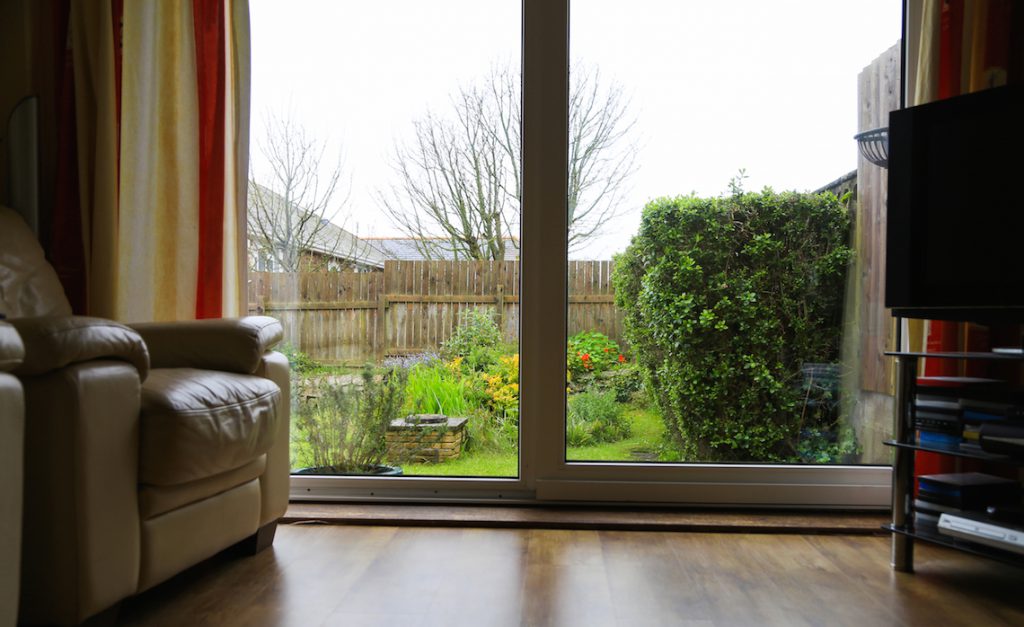
One of the greatest places of energy loss for any home are the sliding glass doors it may have.
When the colder months come along, the cooler air comes through the thin glass of the door, triggering the furnace to work harder and longer.
In order to seal your sliding glass doors, you’ll need to create an artificial double-pane effect to prevent cold air from come into the home and the warm air from escaping.
Here are the steps to follow if you want to know how to seal sliding glass doors in an effective manner.
Step #1: Close And Lock Your Door.
If you don’t lock your door, then the following steps will be much more difficult to complete.
You will be working to reduce overall energy loss through temperature changes instead.
Unlock your door only for the installation of weather stripping and/or compression strips if they are needed.
Step #2: Measure Your Door For Size – Not The Glass.
You will be installing an insulation panel over the glass on your sliding door.
In order to properly install it, you’ll need the measurements of your door frame and panels. Many folks just measure the areas of glass and this creates problems with the installation.
If you need to make marks on your door to keep track of measurements, then make sure you use a pencil.
Measure from the outside edges of the flat door and the sides of the stationary panel in addition to the height measurements.
Step #3: Clean Out Your Door.
A sliding glass door can get an amazing amount of dirt and debris trapped in its tracks.
This may contaminate your insulation panel when installing it, so make sure you take the time to thoroughly clean the door frame.
If you have mold or mildew in the frame, then use antibacterial wipes to clean away the mess for best results.
Mold and mildew spray cleaners can be corrosive to your frame and the glass itself.
Step #4: Cut Your Insulation Panel.
Most insulation panels are made from a thin sheet of plastic. It is very reminiscent of shrink wrap. Use the measurements made earlier to cut the plastic to size.
Follow the manufacturer’s instructions on how to properly install the plastic wrap once it has been sized correctly.
You may need to shrink the plastic with a hot hair dryer or other household appliance to create the energy efficient barrier against the cold that you need.
If you need to affix the plastic to the door frame, use a double-sided tape for best results.
Step #5: Install Any Weather Stripping That May Be Needed.
Most sliding glass doors are installed with weather stripping already in place.
If you look between the two glass panels, you’ll likely see brush fin or fin seal weather stripping in place.
If not, then you’ll want to install this after you’ve finished with the insulation panel.
Peel the backing off of the weather stripping where indicated and then install on the frame of the door and not the glass.
Glass collects condensation that will eventually cause the weather stripping to fall off. Continue until the gap between the doors has been completely filled.
Step #6: Install Compression Strips If Necessary.
Compression strips are usually made from rubber or a similar synthetic material. They are cut to size for the length of the sliding door channel.
Their goal is to seal the channels which may exist around the sash for the door.
You may also wish to install these strips along the vertical seals of where the door locks if there are gaps that can be seen in the frame of the door.
Make sure the strips you purchase are both moisture and chemical resistant for best results.
Step #7: Test Your Results.
Now that you’ve installed all of your weather-proofing components, it is time to give your door a test run.
If your furnace is still working harder than it should be to maintain a consistent indoor temperature, then you may have left an insulation gap for your sliding glass door.
Repeat the steps to make sure that you’ve covered everything.
A second layer of glass insulation may also be necessary for homes that see temperatures that are regularly below freezing.
Knowing how to seal sliding glass doors can save you a bundle on your utility costs throughout the colder months. Gather your products, follow these steps, and you’ll be able to have a home that is warmer all Winter long.



